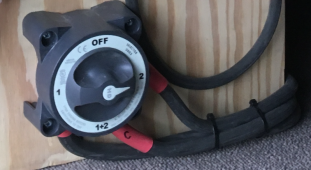Good points. In my case I already had the LA I wanted to keep to preserve my investment in it, increase overall capacity and performance by adding lithium, and as mentioned I have an alternator attached (wind turbine) that I want it to stay connected all of the time to a load (like any alternator).
Regarding the self discharge concerns, the difference between the float voltages is not much at night and the actual nightly self-discharge draw of my lead on my lithium seems quite negligible. in any event, I generally keep loads on at night (inverter, refrigerator, computer, mobile router, intermittent well pump, etc.) so the power going primarily from my lithium feeds those draws and keeps my lead acid from dropping much below 25.6v all night, which is one of the benefits of the combined system, frankly.
To be clear, I don't suggest making full-time parallel connections between lead acid and lithium; rather, based on their differences they can be in parallel most, but not all of the time. and I have found the best way is using the BBMS device that combines and disconnects under the right circumstances using a large relay (I use a bi-stable). Clearly, the banks need to disconnect for significant periods to account for the different charging parameters. When the charging source(s) fills the lithium up, for example, they must disconnect if more power is being provided to the system, otherwise the lithium would overcharge. Because after disconnection there is only LA attached to the system, the charging voltage then naturally rises out of the lithium safe range and the lead goes through its normal daily charging cycle (I have not had to change the charging profile on my Morningstar controllers). The banks should only be reconnected when the charging sources have ceased sufficiently for the banks' voltages to align at the same value so as to prevent inrush (and the combiner has to be smart enough to know, based on how full the lithium is, not to recombine and keep the banks connected even if the voltages are briefly aligned mid-day, for example).
The point is that the BBMS is sort of like a battery combiner (linked to above by CB-OTB), but it is a lot smarter than a device that just combines and disconnects on a set voltage. With the BBMS you program with the actual battery capacity, and it measures current in and out of your lithium so it will only charge to a percentage of that capacity (again, whatever you set it at - If I am going to be away a long time I can set it at 50-60%), and then disconnect. Purely voltage based combiners for lead and lithium risk overcharge of lithium - it can overcharge even at a relatively low voltage if kept there too long. So purely voltage based combiners are not sufficient in my view. And as always, precautions need to be taken with these very powerful batteries, including keeping both banks independently and properly fused.
Your mileage may vary.




